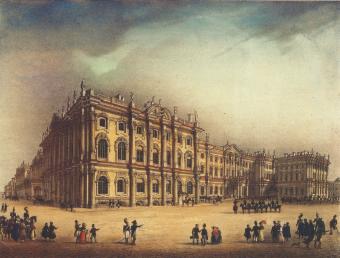Winter Palace
Categories /
Architecture/Architectural Monuments/Palaces
WINTER PALACE, the Great Winter Palace (38 Dvortsovaya (Palace) Embankment), a Baroque architectural monument (1754-1762, architect F.B. Rastrelli). Up until 1917, it remained the main Imperial residence in St. Petersburg, used for official ceremonies of state importance, and included space for galas, quarters and service rooms. It is one of the largest palaces in Europe. The three-storied building forms a square of four outbuildings with inner courtyards (the length of the facade overlooking the Neva river is 137 metres, of the one facing the Main Admiralty - 106 metres, the height is 23.5 metres, there are about 1050 rooms). The palaces unique facades are created thanks to impressive corbels, the division of the walls into two tiers of columns, the varying richness of window-frame modelling, the delightful, infinite play of light and sculptural plasticity of the architectural forms of the palace's. A balustrade runs along the perimeter of the roof with 178 vases and statues (in 1892-1894 the original stone ones were replaced by brass planers). The lavishness of the varying plaster was emphasised with colours: golden-sandy colouring of the walls with the whitewashing accentuation of decorative details (later it was coloured dark red with a double layer; the present colouring has existed since 1946). In the Baroque enfilades of the halls in front of the Jordan Staircase and The Winter Palace Cathedral created by Rastrelli stand out. Later on architects Y.M. Felten, G. Quarenghi (Throne Georgievsky Hall), I.E. Starov and A.A. Montferrand (Petrovsky Hall) worked on the interior design. In 1826, the Military gallery was arranged. On 17 December 1837, a disastrous fire (see Fire of the Winter Palace, 1837) burnt practically all the interiors. In 1838-1839, the Winter Palace was restored (architects V.P. Stasov, A.P. Bryullov, A.E. Shtaubert): in some interiors the original decor was preserved, others were created anew (Malachite Hall and a row of sitting-rooms in the south-western part of the palace, Emblem Hall and others). The main entrance to the Winter Palace is from the side of the Neva River (it was called Jordanian due to the ceremony of water consecration held on Epiphany day). From the side of Palace Square there is a threefold arch with a wrought gate, leading to the inner court, and two porches: Her majesty (nowadays Oktyabrsky) and Komendantsky. From the side of the Main Admiralty there is Saltykovsky (or His Majesty's) porch. Under Emperor Nicholas I, the tradition of a New Year's reception existed: on 1 January, up to 10,000 people would be invited to come to the Winter Palace. On 5 February 1880, a member of Narodnaya Volya (People's Will) S.N. Khalturin organised an explosion in the Winter Palace with the intention of assassinating Emperor Alexander II. Under Emperors Alexander III and Nicholas II the Winter Palace was used mainly for official ceremonies. During the First World War of 1914-18, a military hospital was set up in the halls of Nevsky Enfilade. After the February Revolution of 1917 the Provisional Government operated from the Winter Palace. On the night of 26 October 1917 sailors and Red Guards, occupied the palace and arrested ministers of the Provisional Government, meeting practically no resistance (in Soviet literature this event was interpreted as "the storming of the Winter Palace"). In 1918, the Winter Palace was renamed the Palace of Arts, there political meetings, cinema shows and theatrical performances were held; Narkompros (Peoples' Commissariat of Education) was located in the building. In 1922, the majority of the halls were given over to the State Hermitage. Until 1945, a number of apartments ("historical" quarters and others) belonged to the Museum of the Revolution. During the Siege of 1941-1944 the Winter Palace suffered from air raids. The palace's basement served as a dispensary for scientists and cultural workers, suffering from dystrophy. In 1945-1946, reconstruction work was carried out, at the same time the whole Winter Palace was given over to the Hermitage. In 2001, for the first time the inner courtyard of the Winter Palace, where nowadays summer symphony concerts are held regularly, was opened to the public.
References: Пилявский В. И. Зимний дворец. Л., 1960; Несин В. Н. Зимний дворец в царствование последнего императора Николая II (1894-1917). СПб., 1999; Зимний дворец: Очерки жизни имп. резиденции. В 3 т. Т. 1: XVIII - первая треть XIX в. СПб., 2000.
Y. M. Piryutko.
Persons
Alexander II, Emperor
Alexander III, Emperor
Bryullov Boris Pavlovich
Felten Yury (Georg Friedrich) Matveevich
Khalturin Stepan Nikolaevich
Montferrand Auguste Augustovich (Henri Louis Auguste Leger Ricard de)
Nicholas I, Emperor
Nicholas II, Emperor
Quarenghi Giacomo
Rastrelli Francesco de
Shtaubert Alexander Egorovich
Starov Ivan Egorovich
Stasov Vasily Petrovich
Addresses
Dvortsovaya Embankment/Saint Petersburg, city, house 38
Bibliographies
Пилявский В. И. Зимний дворец. Л., 1960
Несин В. Н. Зимний дворец в царствование последнего императора Николая II (1894-1917). СПб., 1999
Зимний дворец: Очерки жизни имп. резиденции: В 3 т. Т. 1: XVIII - первая треть XIX в. СПб., 2000
The subject Index
Provisional Government of 1917
Hermitage
Chronograph
1754
1762
1827
1880
1932















